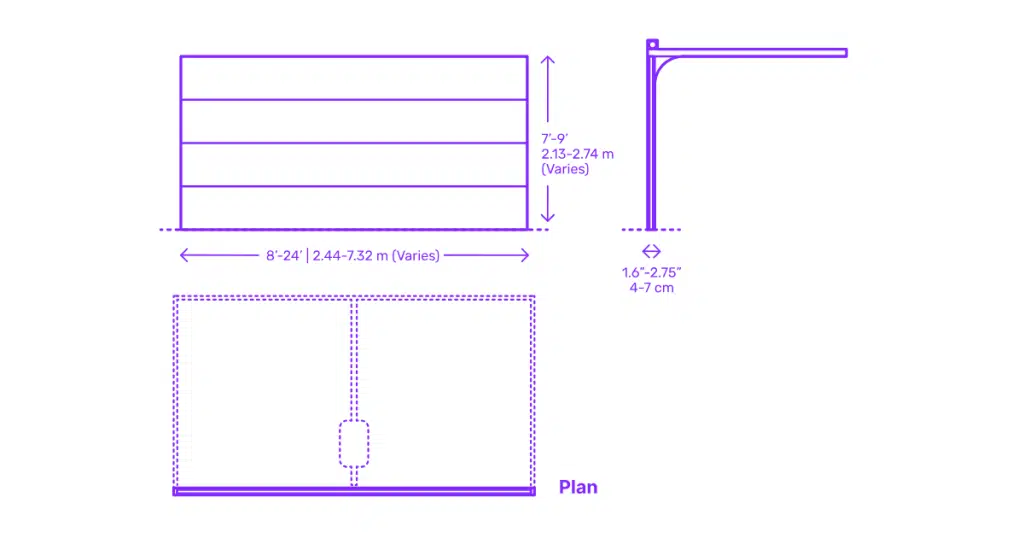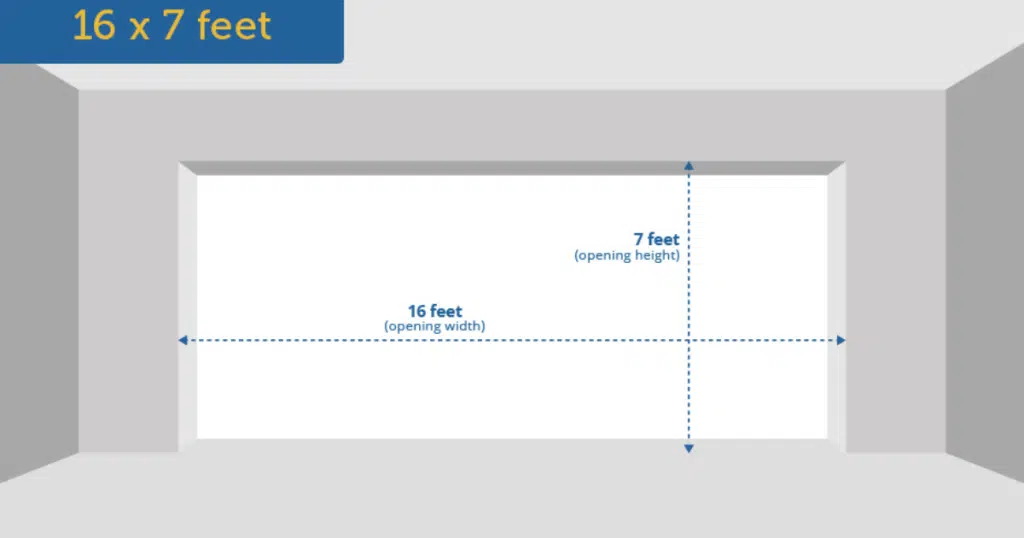How wide is a single garage door? Discover standard garage door widths and learn how to choose the perfect size for your driveway.
Choosing the right garage door size is a critical decision when building, renovating, or replacing your garage door. One of the most commonly asked questions homeowners have is, “How wide is a single garage door?” This is an essential consideration because the door’s width directly affects vehicle clearance, storage accessibility, and the overall functionality of your garage space.
While it might seem like a minor detail, the width of your garage door impacts how easily you can park your car, open doors, or move large items in and out. Whether you’re purchasing a door for a single-car garage or customizing a space for multiple uses, knowing the correct width will help you avoid headaches later.
In this comprehensive guide, we will outline the standard sizes, explore options for custom widths, and provide practical advice on selecting the ideal garage door width for your property. If you’re wondering how wide a single garage door is, this post provides the information you need to make an informed decision.

Standard Widths: What to Expect from Most Single Garage Doors
Most single garage doors range in width from 8 to 10 feet. The most common size installed in modern homes is 9 feet wide, as it offers a good balance between accessibility and space efficiency. An 8-foot-wide door may still be sufficient for smaller cars, but can be tight for wider vehicles like SUVs or trucks.
A 10-foot-wide door offers more clearance and is often preferred in newer home construction or by homeowners who want extra room to maneuver. Regardless of width, most single garage doors are typically 7 to 8 feet tall. These dimensions comfortably accommodate most standard vehicles.
Understanding these standard widths is essential if you’re replacing an existing garage door or designing a new build. If you’re unsure which width works best, always measure your garage opening and vehicle dimensions before making a decision. This helps determine exactly how wide a single garage door needs to be to meet your everyday needs.
When to Consider a Custom-Width Garage Door
There are cases when a standard garage door size may not be ideal. If your garage is part of a custom home design or if you plan to store oversized vehicles, boats, or other large equipment, a wider garage door may be necessary.
Custom widths can be designed to suit the exact needs of your home, whether that means expanding to 12 feet or fitting a non-standard opening. While custom doors may come with a higher price tag, the benefits in terms of functionality and appearance often justify the investment.
Before deciding on a custom width, consider future needs as well. If you can upgrade to a larger vehicle or want more versatile access, building in extra space from the start can save you from having to upgrade again later. These planning decisions all tie back to understanding how wide a single garage door is and what your future requirements might look like.
Key Factors That Influence Garage Door Width
Choosing the correct width isn’t just about what looks good—it’s also about practicality. Here are some key considerations:
1. Vehicle Size
The size of your vehicles is one of the most critical elements when determining garage door width. Think beyond just fitting your car inside—ensure there’s enough space for comfortably maneuvering in and out. Consider the dimensions of your largest vehicle, including SUVs, trucks, or recreational vehicles, and allow room for side mirrors, opening doors, and safe clearance on both sides. If you’re planning for future vehicle upgrades, factor in extra space to avoid needing a renovation down the line.
2. Garage Layout and Structure
Every garage has unique structural constraints that can impact the size of the door. Interior wall spacing, ceiling height, and the location of support beams or load-bearing walls can all limit the width of a door that can be installed. The positioning and type of garage door tracks—whether overhead, side-mounted, or custom systems—may also impact the maximum allowable width. A professional assessment can help you identify any physical limitations early in the process.
3. Multi-Use Functionality
Modern garages often serve multiple purposes beyond simply housing vehicles. Many homeowners utilize their garages as workshops, home gyms, craft areas, or storage spaces. In such cases, a wider door can significantly improve access and flexibility. Being able to move large equipment or bulky items in and out easily can make a big difference in how effectively you use the space.
4. Architectural Harmony and Home Appearance
While function is key, form should not be overlooked. The width of your garage door should be in proportion to the overall size and style of your home. A door that’s too narrow or too wide for the front facade can disrupt the visual balance and reduce curb appeal. Coordinating the garage door design with your home’s architectural features, such as rooflines, windows, and trim, helps create a cohesive and attractive exterior.
5. Long-Term Planning and Professional Guidance
Choosing the right garage door width is an investment in both convenience and property value. It’s often worth consulting with a garage door specialist or contractor who can guide you through the technical and design aspects of the decision. They can help you avoid common pitfalls, recommend custom solutions if needed, and ensure your garage door system complies with local building codes and safety standards.
Consulting with a professional can help ensure you don’t overlook critical details during planning and installation.
Types of Garage Doors That Impact Sizing
Your choice of garage door style may also influence the final width. Different types include:
- Sectional Doors: Most common; fit standard openings well and come in multiple panel designs.
- Roll-Up Doors: Space-saving, often used in commercial or compact settings.
- Tilt-Up Canopy or Retractable Doors: Swing outward and require more space in front of the garage.
- Side-Hinged Doors: Traditional look, with limitations on size flexibility.
Each type of new garage door has its own advantages and may be more or less suitable depending on your home and usage needs.
Tips for Choosing the Right Width
- Measure Everything: Get accurate measurements of your garage opening, vehicle width, and ceiling height.
- Think Long-Term: If you’re planning to upgrade vehicles or change the garage’s use, account for that now.
- Check Local Codes: Some communities have requirements for driveway clearance or garage design.
- Work with Experts: Professional installers can help you find a size that meets both your functional and aesthetic needs.
By considering these tips, you’ll gain clarity on how wide a single garage door fits your current and future requirements.

FAQs About How Wide Is a Single Garage Door
What is the standard width of a single garage door?
The standard width is 9 feet, though 8- and 10-foot options are also common depending on the home design.
Is a 10-foot-wide garage door better than a 9-foot one?
A 10-foot-wide door provides more clearance and is ideal for larger vehicles. However, a 9-foot door is sufficient for most standard-sized cars.
Can I install a wider garage door in an existing garage?
In many cases, yes. But structural modifications might be needed. Always consult a garage door professional before proceeding.
Do custom garage door widths cost more?
Yes, custom sizes typically come with added manufacturing and installation costs, but offer flexibility in design and functionality.
How do I measure the width of my garage door opening?
Measure from the inside of one side of the finished garage opening to the other side. Always measure twice to ensure accuracy.
Conclusion
If you’ve been asking how wide a single garage door is, the answer ultimately depends on your home, your vehicles, and how you use your space. While the general range is 8 to 10 feet, selecting the right width will enhance your garage’s convenience, accessibility, and usability.
Taking the time to evaluate your garage’s layout, including your current and future vehicle sizes, and how you use the space, will help you make the best choice. Getting the door size right at the beginning prevents costly changes later and ensures smooth everyday operation.
For help selecting and installing the perfect new garage door, contact the professionals at Royale Garage Door Service, Inc. in Mission Viejo, CA. Our experienced team is here to help you make the most practical and efficient choice for your home.
End Note
Royale Garage Door Service, Inc. offers high-quality garage door solutions tailored to meet your specific needs. Whether you’re replacing an outdated door or installing a new one for your custom home, our team of experienced technicians guarantees quality work and long-term satisfaction. Learn more about us by visiting our comprehensive About Us page.
We specialize in everything from garage door installation to emergency repairs and maintenance across our service areas. Our Overhead Door Mission Viejo offerings are built for efficiency, security, and style. If you’re interested in cost-saving opportunities, don’t miss our latest specials!
Explore honest customer feedback on our testimonials page or connect with us directly via Facebook, Contact Us, or Get a Quote online today. Royale Garage Door Service, Inc. is proud to serve Mission Viejo and surrounding communities with top-tier garage door service you can trust.




